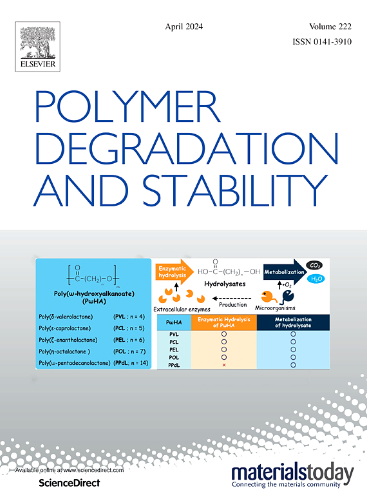Effect of chemical structure on properties evolution and molecular mechanism of polyimide films under ultraviolet irradiation
IF 6.3
2区 化学
Q1 POLYMER SCIENCE
引用次数: 0
Abstract
The focus of this work is a detailed comparative study of the changes induced by ultraviolet (UV) irradiation in polyimide (PI) films with different chemical structures. Five synthesized aromatic PI films were subjected to UV irradiation. The properties and structural evolution resulting from this irradiation were comprehensively evaluated using a combination of experiments and simulations. A mechanism for the UV irradiation-induced molecular chain breakage on the surface of PI films was proposed. After 1600 h of UV irradiation, the mechanical properties, heat resistance, and other macroscopic properties of the PI films were maintained at >70 % of their original values, and the surface of the PI films showed damages such as holes and cracks after UV irradiation. The mass loss and thickness loss of PI films caused by UV irradiation exhibited a strong correlation, while the density remained basically unchanged. In addition, an increase in the surface hydrophilicity of the PI films was observed. There was a breakdown of surface –C–C–, –C–N–, and –C–H bonds, accompanied by an increase in the content of –C–O– and –C=O bonds. Based on experimental surface characterization, it was proposed that UV irradiation of PI films primarily occurs at the surface. Molecular simulations were performed to calculate the energy gap to undergo energy level jumps and the energy of the chemical bonds to break for the PI films, and it was hypothesized that the UV irradiation resistance of the PI films is related to the optical transmittance and the ease of charge-transfer complex (CTC) formation.

紫外线照射下聚酰亚胺薄膜化学结构对性能演变的影响及分子机理
本文对不同化学结构的聚酰亚胺(PI)薄膜在紫外线照射下的变化进行了详细的比较研究。对五种合成的芳香族PI薄膜进行了紫外照射。采用实验和模拟相结合的方法,对辐照后材料的性质和结构演变进行了综合评价。提出了紫外辐射诱导PI膜表面分子链断裂的机理。紫外线照射1600 h后,PI膜的力学性能、耐热性等宏观性能保持在原始值的70%左右,且PI膜表面出现孔洞、裂纹等损伤。紫外辐照引起的PI膜的质量损失与厚度损失具有较强的相关性,而密度基本保持不变。此外,还观察到PI膜的表面亲水性有所提高。表面- c - c -、- c - n -和- c - h键被破坏,同时- c - O -和- c =O键的含量增加。基于实验表面表征,提出了紫外辐照主要发生在PI膜的表面。通过分子模拟计算了PI膜发生能级跃迁的能隙和化学键断裂的能,并推测PI膜的抗紫外辐射能力与薄膜的透光率和电荷转移络合物(CTC)形成的难易程度有关。
本文章由计算机程序翻译,如有差异,请以英文原文为准。
求助全文
约1分钟内获得全文
求助全文
来源期刊

Polymer Degradation and Stability
化学-高分子科学
CiteScore
10.10
自引率
10.20%
发文量
325
审稿时长
23 days
期刊介绍:
Polymer Degradation and Stability deals with the degradation reactions and their control which are a major preoccupation of practitioners of the many and diverse aspects of modern polymer technology.
Deteriorative reactions occur during processing, when polymers are subjected to heat, oxygen and mechanical stress, and during the useful life of the materials when oxygen and sunlight are the most important degradative agencies. In more specialised applications, degradation may be induced by high energy radiation, ozone, atmospheric pollutants, mechanical stress, biological action, hydrolysis and many other influences. The mechanisms of these reactions and stabilisation processes must be understood if the technology and application of polymers are to continue to advance. The reporting of investigations of this kind is therefore a major function of this journal.
However there are also new developments in polymer technology in which degradation processes find positive applications. For example, photodegradable plastics are now available, the recycling of polymeric products will become increasingly important, degradation and combustion studies are involved in the definition of the fire hazards which are associated with polymeric materials and the microelectronics industry is vitally dependent upon polymer degradation in the manufacture of its circuitry. Polymer properties may also be improved by processes like curing and grafting, the chemistry of which can be closely related to that which causes physical deterioration in other circumstances.
 求助内容:
求助内容: 应助结果提醒方式:
应助结果提醒方式:


